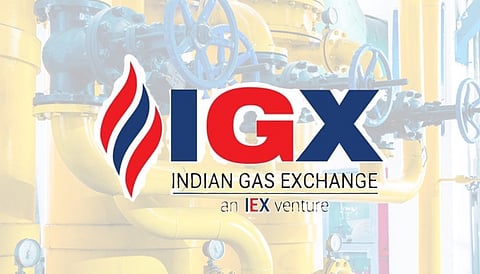
- News Updates
- PSU Watch
- Defence News
- Policy Watch
- हिन्दी न्यूज़
- Jobs Watch
- States News
- Event News

New Delhi: The Indian Gas Exchange (IGX) recorded its highest-ever monthly trading volume in April 2025, even as the Gas IndeX of India (GIXI) showed a 40 percent year-on-year increase to Rs 1,057 or \$12.4 per MMBtu. The monthly figure, however, reflected a 13 percent decline compared to March 2025, attributed to increased availability of liquefied natural gas (LNG) in global markets and higher domestic gas supply.
IGX traded a record 15.9 million MMBtu of gas during April, equivalent to 400 million standard cubic metres (MMSCM), marking a staggering 540 percent jump from the same month last year and a 205 percent increase from March 2025. About 84 percent of the traded volume comprised domestic high pressure high temperature (HPHT) gas priced at the ceiling rate of Rs 861 or \$10.04 per MMBtu, while 16 percent was free-market gas. An additional 0.75 million MMBtu was transacted at pricing freedom points including Bokaro (CBM), KG Basin, and ONGC Hazira.
A total of 290 trades were executed during the month. The most active delivery points were Dahej for free market gas and Gadimoga for ceiling-priced gas, driven by increased sales from domestic producers. Other prominent delivery locations included Mhaskal, KG Basin, Bokaro, Mallavaram, Hazira, and Dabhol. Exchange-traded physical deliveries during the month stood at 6.6 million MMBtu (\~5.6 MMSCMD).
For the first time, IGX executed a Long Duration Contract (LDC) in April, covering a three-month delivery period from May to July 2025. A volume of 0.32 million MMBtu was traded under this contract at Hazira, benchmarked against Platts West India Marker (WIM®).
Regionally, GIXI-West outpaced the national average at Rs 1,070 or \$12.5 per MMBtu, while GIXI-East and GIXI-South lagged behind due to transmission and tax-related cost differentials, settling at Rs 1,005 (\$11.7) and Rs 975 (\$11.4) per MMBtu, respectively. GIXI-Dahej, a key benchmark, declined 15 percent month-on-month to Rs 1,026 or \$12 per MMBtu—trading at an \$2.7/MMBtu (18 percent) discount compared to WIM-Ex Dahej for April.
On the global front, international gas benchmarks also showed a similar trend—high on a yearly basis but declining month-on-month. The Dutch TTF averaged \$11.6/MMBtu (27 percent up YoY, 13 percent down MoM), WIM averaged \$12.52/MMBtu (16 percent up YoY, 12 percent down MoM), while the U.S. Henry Hub (HH) benchmark stood at \$3.45/MMBtu (94 percent up YoY, 16 percent down MoM).
IGX currently facilitates trade at 17 delivery points, including five LNG terminals, nine domestic gas field landfall points, and three pipeline interconnection points. The exchange offers a range of delivery-based contracts including Intraday, Day-Ahead, Daily, Weekday, Weekly, Fortnightly, and Monthly spot contracts, along with 3-month and 6-month long duration contracts linked to various international and domestic benchmarks such as GIXI, JKM®, WIM®, and Dated Brent®.
In April, the most active contracts were Daily (108 trades), Monthly (107), Weekly (49), Day-Ahead (13), Fortnightly (12), and a single 3-month LDC trade.
The surge in trading activity and diversification of contract offerings signal growing maturity and depth in India’s gas markets, supporting the government’s goal of increasing the share of natural gas in the country’s energy mix.
(PSU Watch– India's Business News centre that places the spotlight on PSUs, Bureaucracy, Defence and Public Policy is now on Google News. Click here to follow. Also, join PSU Watch Channel in your Telegram. You may also follow us on Twitter here and stay updated.)
